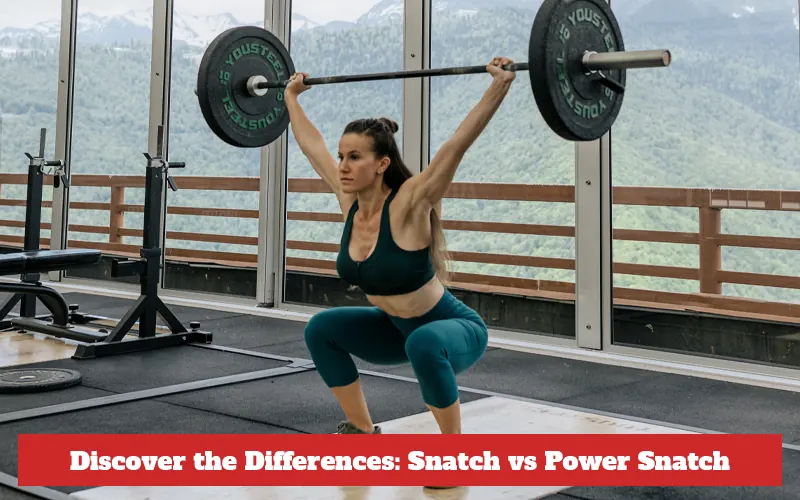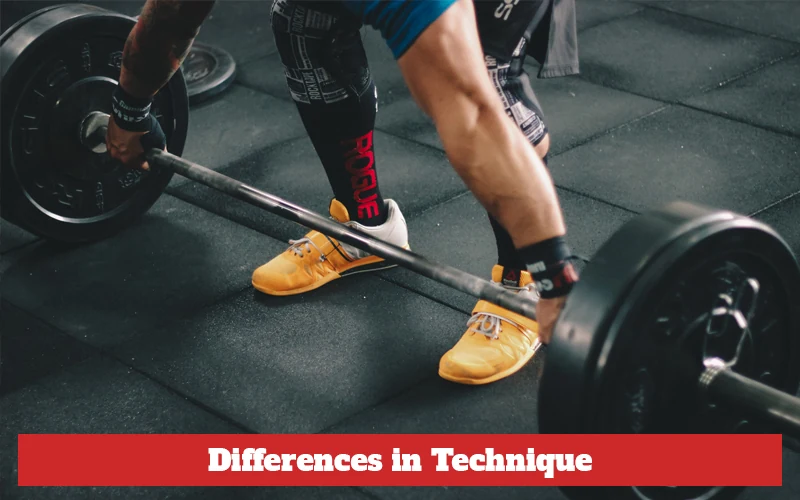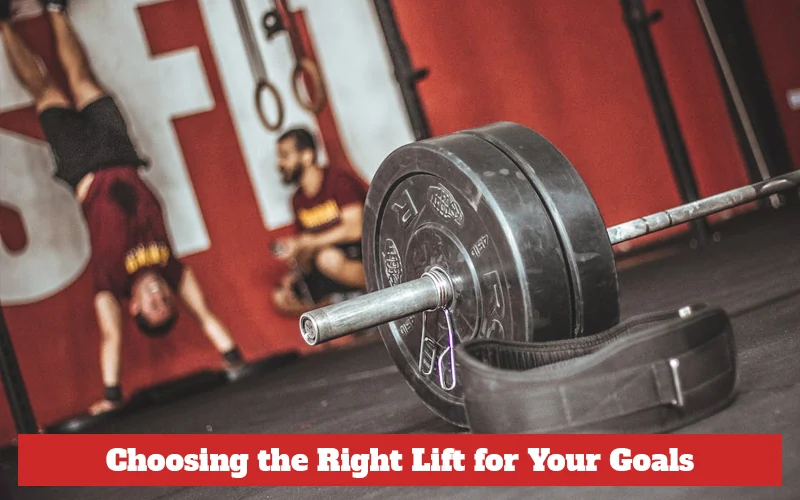
Are you a weightlifter or fitness enthusiast looking to take your training to the next level? If so, you've likely heard of the snatch and power snatch - two common exercises that are often confused with each other. While they may seem similar, these lifts have distinct differences that can impact your overall performance and goals.
In this blog post, we'll explore the key differences between snatch vs power snatch to help you understand the unique benefits and techniques of each exercise. We'll dive into the mechanics of each lift, the muscle groups they target, and the varying levels of difficulty. Whether you're a beginner or a seasoned lifter, this guide will equip you with the knowledge and tools to take your training to new heights.
So, are you ready to unlock the secrets of snatch and power snatch? Let's dive in and explore the differences between these two powerful lifts.
What is the Snatch?
The snatch is an Olympic weightlifting exercise that involves lifting a barbell from the ground to overhead in one smooth motion. The goal is to lift the barbell from the ground to a locked-out overhead position in one continuous movement. The snatch is a complex lift that requires a combination of strength, speed, and technique.
The snatch involves a wide grip on the barbell and a quick, explosive pull to lift the weight overhead. The lifter must maintain a stable position throughout the lift, using their hips, legs, and back muscles to generate power and momentum. The snatch is often considered one of the most technically challenging lifts in weightlifting, requiring precise form and timing to execute correctly.
The snatch is a full-body exercise that targets several muscle groups, including the legs, back, shoulders, and arms. It is a highly effective exercise for building explosive power, speed, and strength. The snatch is a staple exercise in Olympic weightlifting, but it can also be incorporated into other strength and conditioning programs.
Also read: Maximize Training: Perform One Arm Dumbbell Snatch
What is the Power Snatch?
The power snatch is a variation of the snatch weightlifting exercise. Similar to the snatch, the goal of the power snatch is to lift a barbell from the ground to an overhead position. However, in the power snatch, the lifter catches the barbell in a partial squat position rather than a full squat position.
In the power snatch, the lifter begins with the barbell on the ground and uses a wide grip to pull the weight upwards. The lifter then quickly drops under the bar and catches it in a partial squat position, with the hips above parallel. The lifter then stands up with the weight overhead, completing the lift.
The power snatch requires explosive power and speed, as well as good technique and timing. It targets many of the same muscle groups as the snatch, including the legs, back, shoulders, and arms. However, because the lifter catches the barbell in a higher position, the power snatch places less stress on the lower body than the full snatch.
The power snatch is often used by weightlifters and athletes to improve their explosive power and speed. It can also be used as a variation or progression of the snatch, allowing lifters to gradually increase the difficulty of the lift over time.
Differences in Technique

The snatch and power snatch lifts differ in technique in several ways. Here are some of the key differences:
- Starting Position: In the snatch, the lifter starts in a squat position with the hips lower than in the power snatch. In the power snatch, the lifter starts with their hips slightly higher, in a partial squat position.
- Bar Path: In the snatch, the lifter pulls the barbell in a straight line, close to their body, until it reaches their hips. The lifter then explosively extends their hips and pulls the barbell vertically, allowing it to travel overhead in a smooth and continuous motion. In the power snatch, the lifter pulls the barbell upwards in a straight line, but the path of the barbell is shorter, as the lifter catches the barbell in a higher position.
- Catch Position: In the snatch, the lifter catches the barbell in a full squat position, with their hips below parallel. In the power snatch, the lifter catches the barbell in a partial squat position, with their hips above parallel.
- Difficulty: The snatch is considered a more difficult lift than the power snatch because it requires greater mobility, strength, and technical proficiency. The power snatch is a slightly easier variation, as the lifter catches the barbell in a higher position and places less stress on the lower body.
Overall, the snatch and power snatch require different levels of technique, strength, and mobility. Each lift has its own benefits and challenges, and both can be useful for improving athletic performance and building strength and power.
Differences in Muscle Groups Targeted
Although the snatch and power snatch lifts share some muscle groups, they differ in how those muscle groups are targeted. Here are the key differences between snatch vs power snatch:
- Lower Body: Both lifts target the quadriceps, hamstrings, and glutes, but the snatch places a greater emphasis on the lower body because of the deeper squat position required for the catch. The power snatch is a faster, more explosive lift that emphasizes the hip extension and uses less knee flexion, which means it places less stress on the lower body.
- Upper Body: Both lifts target the upper back, shoulders, and arms. However, the snatch requires greater upper body strength and mobility because of the overhead position of the barbell. The power snatch also targets these muscles, but to a slightly lesser extent because the barbell is caught in a higher position.
- Core: Both lifts require significant core strength and stability to maintain proper technique and form throughout the lift. The snatch places a greater demand on the core because of the deeper squat position, which requires more abdominal and lower back engagement.
In general, both lifts target the lower body, upper body, and core, but the emphasis on each muscle group differs. The snatch places a greater demand on the lower body and upper body, while the power snatch is a faster, more explosive lift that targets the hips and upper body to a slightly lesser extent.
Variations and Progressions
There are several variations and progressions of the snatch and power snatch that can help lifters gradually increase the difficulty of the lift and improve their technique. Here are some examples:
- Hang Snatch: This variation of the snatch involves starting the lift from a hang position, rather than from the ground. The lifter begins with the barbell at mid-thigh level, which requires greater explosiveness and technique in the pull.
- Snatch Balance: This exercise is designed to improve the lifter's technique and speed under the bar. It involves starting in a partial squat position and quickly dropping into a full squat position as the barbell is lifted overhead.
- Overhead Squat: This exercise targets the same muscle groups as the snatch and power snatch but focuses on improving lower body strength and stability. The lifter holds the barbell overhead and performs a squat, keeping the barbell balanced and stable throughout the movement.
- Snatch Pull: This exercise targets the initial pull of the snatch and helps the lifter improve their technique and power in this phase of the lift. It involves performing the initial pull of the snatch, but without completing the full lift.
- Hang Power Snatch: This variation of the power snatch involves starting the lift from a hang position, rather than from the ground. The lifter begins with the barbell at mid-thigh level and catches the barbell in a partial squat position.
These variations and progressions can help lifters improve their technique and gradually increase the difficulty of the lift over time. They can also provide a way to target specific muscle groups or phases of the lift that need improvement.
Choosing the Right Lift for Your Goals

When deciding whether to perform the snatch vs power snatch, there are several factors to consider:
- Experience Level: The snatch requires greater technical proficiency and mobility than the power snatch. If you're new to weightlifting or still developing your technique, it may be better to start with the power snatch and gradually progress to the snatch as your skills improve.
- Goals: The snatch and power snatch have different benefits and can be used to target different areas of your training. The snatch is a more comprehensive lift that targets a wider range of muscle groups and can be useful for improving explosive power and overall strength. The power snatch is a faster, more explosive lift that can be useful for improving speed and power in specific movements or sports.
- Physical Limitations: If you have any physical limitations, such as limited mobility or injuries, you may need to choose one lift over the other. For example, if you have limited mobility in your hips, the power snatch may be a better option for you.
- Training Program: Your training program and schedule may also play a role in determining which lift is right for you. If you have limited time for training, the power snatch may be a more efficient option because it requires less time and preparation than the snatch.
Overall, the choice between the snatch and power snatch depends on your experience level, goals, physical limitations, and training program. Both lifts have unique benefits and challenges, so it's important to choose the one that best aligns with your needs and abilities.
Common Mistakes and How to Avoid Them
Here are some common mistakes made when performing the snatch and power snatch, along with tips on how to avoid them:
- Incorrect Grip: One of the most common mistakes is using the wrong grip on the barbell. For the snatch, the grip should be wide enough to allow the lifter to drop into a full squat position. For the power snatch, the grip can be slightly narrower. Make sure to position your hands correctly before beginning the lift.
- Poor Technique: Proper technique is essential for both the snatch and power snatch. Common mistakes include not keeping the barbell close to the body during the pull phase, not fully extending the hips, and not catching the barbell in the correct position. Work with a coach or trainer to improve your technique and form.
- Lack of Mobility: The snatch requires a greater range of motion than the power snatch, so mobility is essential for proper execution. Make sure to stretch and warm up properly before attempting either lift, and work on improving your flexibility and mobility through targeted exercises and drills.
- Insufficient Power: Both lifts require a significant amount of power and explosiveness. Common mistakes include not generating enough power in the pull phase, not fully extending the hips, and not using the legs and back muscles effectively. Focus on generating power from the hips and legs, and practice explosive movements to improve your power output.
- Rushing the Lift: The snatch and power snatch require speed and explosiveness, but rushing the lift can lead to poor technique and form. Take your time to set up and position the barbell correctly, and focus on executing each phase of the lift with proper technique and form.
In general, common mistakes when performing the snatch and power snatch include using the wrong grip, poor technique, lack of mobility, insufficient power, and rushing the lift. Work on improving your technique, mobility, and power, and take your time to execute each phase of the lift with proper form and technique.
Conclusion
In conclusion, the snatch and power snatch are two common weightlifting exercises that have distinct differences in technique, muscle groups targeted, and difficulty level. While both exercises can be effective for improving athletic performance and building strength and power, they require different levels of skill and experience.
To get the most out of these lifts, it's important to choose the one that aligns with your goals and abilities. Factors to consider include your experience level, physical limitations, training program, and goals. It's also important to avoid common mistakes when performing these lifts, such as using the wrong grip, poor technique, lack of mobility, insufficient power, and rushing the lift.
Incorporating variations and progressions of these lifts can help lifters improve their technique, gradually increase the difficulty of the lift, and target specific muscle groups or phases of the lift. With proper technique, form, and training, the snatch and power snatch can be valuable exercises for improving athletic performance and building strength and power in the lower body, upper body, and core.